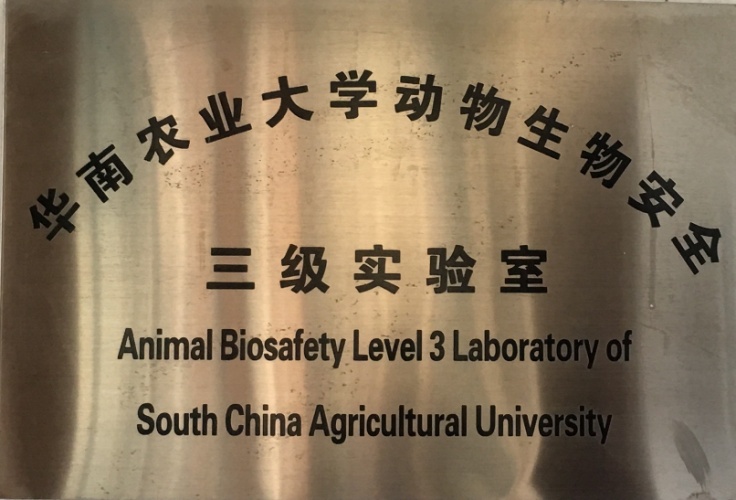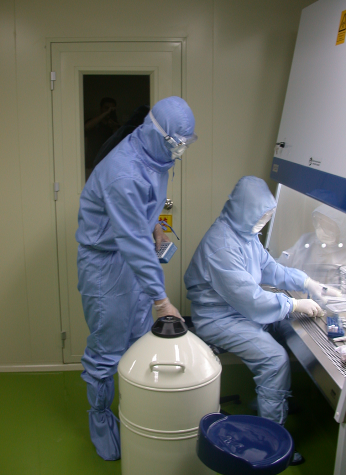time:2020-05-05 view:912

As the national advanced biosafety laboratory planned by the National Development and Reform Commission, the animal biosafety level 3 laboratory of South China Agricultural University has been examined by Ministry of Science and Technology. The laboratory is affiliated to the South China Agricultural University College of Veterinary Medicine, formerly known as Ministry of Agriculture and Rural Affairs key open laboratory and biosafety level 3 laboratory of poultry farming and poultry disease prevention and control. The laboratory is constructed and run mainly relying on the state key disciplines of veterinary medicine prevention and control, the national local joint engineering laboratory for the prevention and control of zoonotic diseases, the key laboratory for the production of veterinary vaccines under the Ministry of Agriculture and Rural Affairs, the key laboratory of zoonosis of Ministry of Agriculture and Rural Affairs and the Guangdong Provincial key Laboratory for the Prevention and Control of Animal-original zoonosis.
The main research object in the laboratory is avian influenza and other important zoonosis. As early as 1995, with the approval of the Ministry of Agriculture and Rural Affairs, the laboratory can carry out the genetic diagnosis and molecular epidemiology research on avian influenza. The Ministry of Agriculture and Rural Affairs has invested in the construction of the key open laboratory facilities for poultry farming and poultry disease control in 2001. One year later, Ministry of Agriculture and Rural Affairs funded for establishment of a key open laboratory and biosafety level 3 laboratory of poultry farming and poultry disease prevention and control. In 2004, the laboratory underwent the first transformation and in 2006, the second modification was carried out according to the requirements of the General Laboratory Biosafety requirements (GB19489-2004). In 2007, the qualification of the BSL-3 Laboratory was certificated by the China National Accreditation Service for Conformity Assessment(CNAS). In the same year, the laboratory was approved by Ministry of Agriculture and Rural Affairs to do research of high pathogenic microorganism. The experiment of highly pathogenic avian influenza in the laboratory was permitted by Ministry of Agriculture and Rural Affairs in 2009. In the same year, the laboratory was renamed as the Biosafety Level 3 Laboratory of South China Agricultural University. In 2011, the laboratory was rebuilt at the new site and renamed as the Animal Biosafety Level 3 Laboratory of South China Agricultural University. In July of the same year, the laboratory was certificated by the CNAS. In December, the laboratory was certificated again by Ministry of Agriculture and Rural Affairs to do research of highly pathogenic animal microorganisms. 
The laboratory has made outstanding contributions to animal-origin zoonosis, such as SARS and avian influenza. In 2003, an atypical pneumonia epidemic outbroke in China, and Guangdong Province set up a leading group on science and technology against atypical pneumonia. Professor Xin Chaoan, the director of the laboratory, became one of the 13 experts. At the same time, he was appointed by Ministry of Agriculture and Rural Affairs as a member of the expert for survey of Animal Coronavirus and do research on tracing SARS. The laboratory has become the 'main battlefield' of tracing SARS. With the efforts of experts such as Xin Chaoan and Liao Ming, the gene of SARS was detected in bats, monkeys, beavers and snakes, which was identical to that of human SARS, and tracing SARS research made a great breakthrough.
At the end of 2003, after the outbreak of highly pathogenic avian influenza in some areas of China, the laboratory became a 'combat base' to fight against avian influenza. As a member of the 'Avian Influenza Expert Group' of Ministry of Agriculture and Rural Affairs, the head of the 'expert Group on the Prevention and Control of Avian Influenza' of Guangdong Province, Professor Xin Chaoan rushed to each epidemic spot in time to estimate situation and carry out research on isolation, identification, mutation, tracing of viruses and provided technical basis for local government decision-making.
In 2009, pandemic H1N1 outbroke in many countries. Professor Liao Ming, the director of the laboratory, the head of a special emergency project study on the Prevention and Control of Human and Animal Influenza A (H1N1) in Guangdong Province, led the team making breakthroughs in research of pathogen, novel vaccines and drugs, and epidemiology.
In 2013, the first outbreak of H7N9 influenza occurred in eastern China. Guangdong Province became a major disaster area in the second wave of the epidemic. Professor Liao Ming, vice president of our school, was appointed as the head of the Expert Group on Pathology of H7N9 Avian Influenza in Guangdong Province. The laboratory collected a large number data, carried out research on aetiology, characteristics and transmission rule of viruses. According to the results of laboratory research, the research group provided suggestions for the provincial government and provided technical supports for “1110 policy’’ and “centralized slaughtering, cold chain distribution and fresh market policy.”
In January 2017, a new highly pathogenic H7N9 influenza virus was first identified by the lab. In response to this discovery, the team immediately informed the relevant departments and quickly developed a specific diagnostic kit, which was provided to the Guangdong Provincial Animal Health Supervision Institute and the Guangdong Provincial Centers for Disease Prevention and Control, and suggested to strengthen the surveillance of H7N9 virus mutation. Then the Guangdong Centers for Disease Control and Prevention found the H7N9 variant strain in two human cases. Our lab has made an outstanding contribution to the early monitoring, prevention and control of highly pathogenic H7N9 virus.
These efforts have promoted our lab to make great achivements in the prevention and control of avian influenza. Now, as a key research laboratory for avian influenza in China, the laboratory plays a role as a “battle fortress” in the surveillance of highly pathogenic avian influenza, the products exploiting for prevention and control of major animal disease products and the basic research of zoonosis.
Achievements:
1. The laboratory has obtained more than 20 awards in recent years and won two of first-class awards in seven years. Among them, the project 'the Development and Application of inactivated Vaccine against H5 subtype Avian Influenza' won the first prize of the National Science and Technology Progress in 2005. The Research and Application of key Technologies for the Prevention and Control of important animal virus disease won the first prize of National Science and Technology Progress in 2012.
2. The laboratory has independently developed the 'inactivated avian influenza vaccine' (a series of products), the Newcastle disease inactivated vaccine and more than a dozen scientific research achievements, which have indirectly or indirectly created more than 10 billion RMB economic benefits. Among them, the new veterinary drug certificate of inactivated Avian Influenza Vaccine (H5N2 subtype, D7 strain) was obtained in 2013, which is the first bird flu vaccine for waterfowl in China. It has become a milestone in avian influenza vaccine research. In 2017, the new veterinary drug certificate of inactivated vaccine against avian influenza virus H5 subtype (D7&rD8 strain) was obtained, which will make a new contribution to the prevention and control of H5 subtype highly pathogenic avian influenza in China.
3. The laboratory published more than 500 articles (including 200 high-level SCI papers) in the past five years.